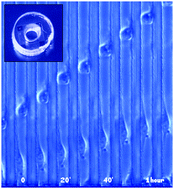When cancer cells spread away from the primary tumor, they often follow the trajectories of lymphatic vessels, nerves, white matter tracts, or other heterogeneous structures in tissues. To better understand this form of guided cell migration we designed a series of microfluidic devices that mechanically constrain migrating cancer cells inside microchannels with cross-section comparable to cell size. We observed unexpectedly fast and persistent movement in one direction for several hours of cancer cells of different types. The persistent motility occurs spontaneously, in the absence of external gradients, suggesting the presence of intrinsic mechanisms driving cancer cell motility that are induced in conditions of mechanical confinement. To probe the mechanisms responsible for this behavior, we exposed cancer cells inside channels to drugs targeting the microtubules, and measured a significant reduction in the average migration speed. Surprisingly, a small number of cells appeared not to be affected by the treatment and displayed fast and persistent migration, comparable to the untreated cells. The new matrix-free, 3D-confined motility assay replicates critical interactions that cancer cells would normally have inside tissues, is compatible with high-content, high-throughput analysis of cellular motility at single cell level, and could provide useful insights into the biology of cancer cell migratory phenotype.

You have access to this article
 Please wait while we load your content...
Something went wrong. Try again?
Please wait while we load your content...
Something went wrong. Try again?


 Please wait while we load your content...
Please wait while we load your content...